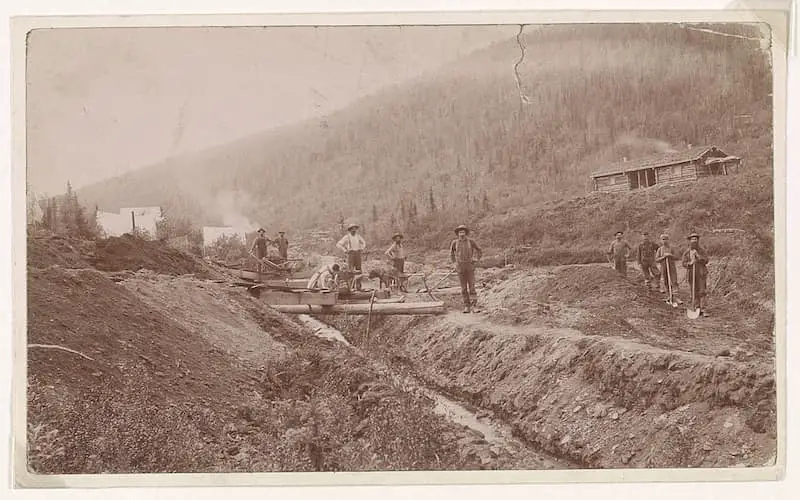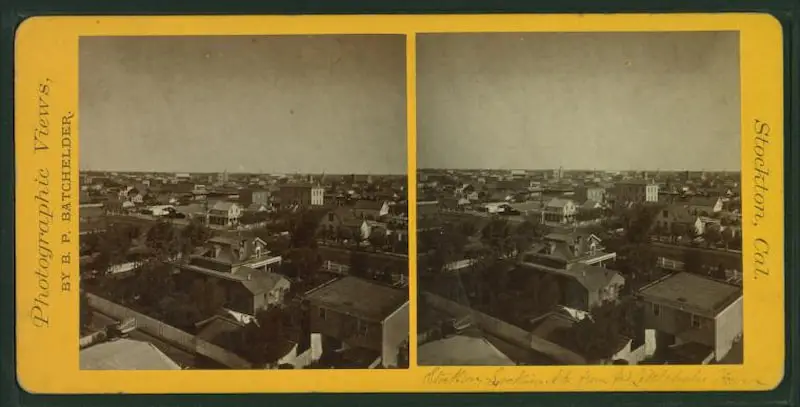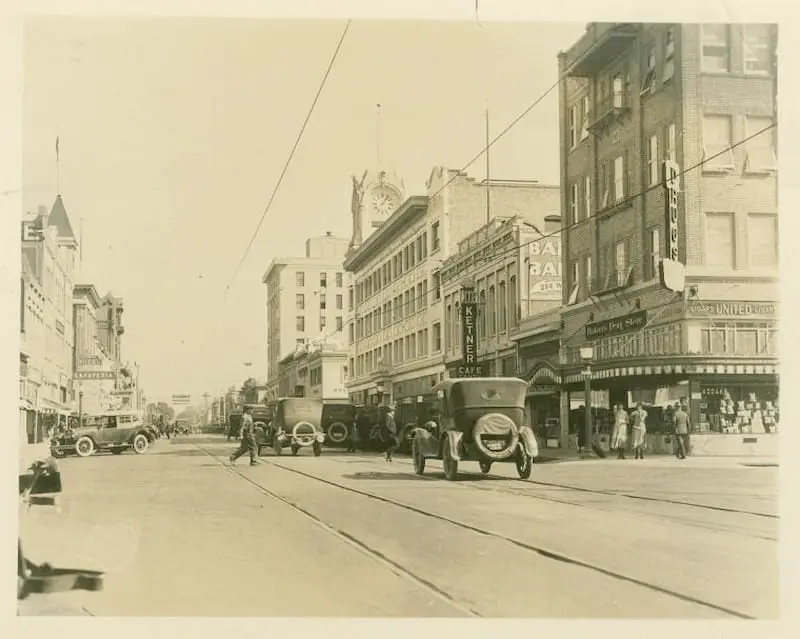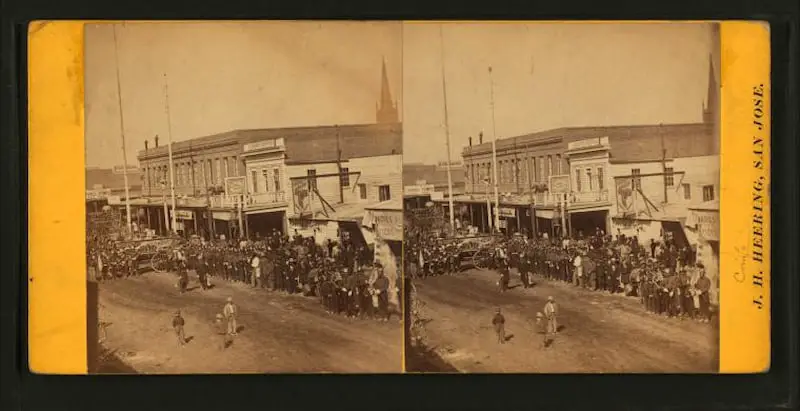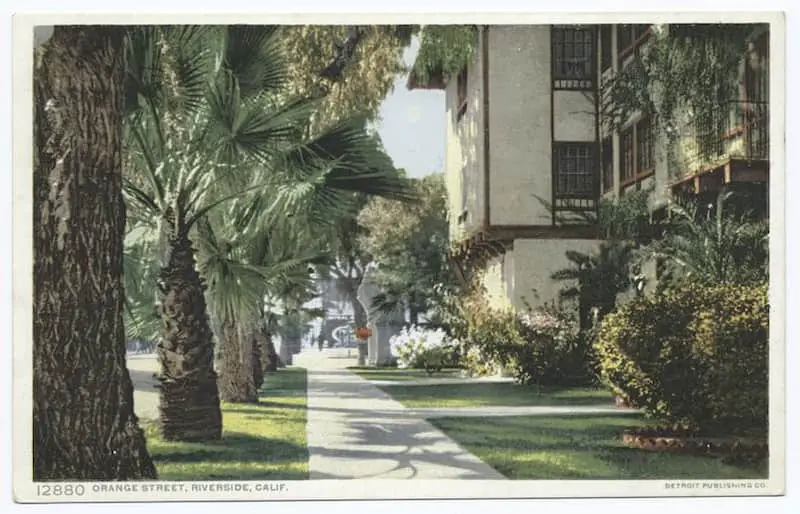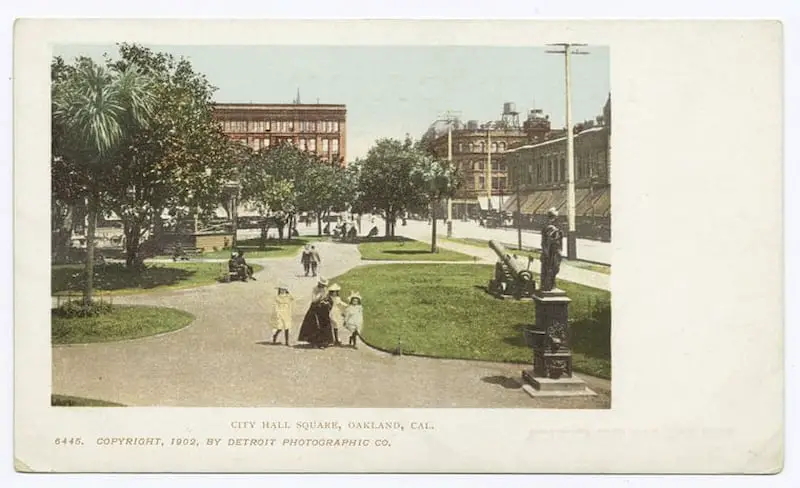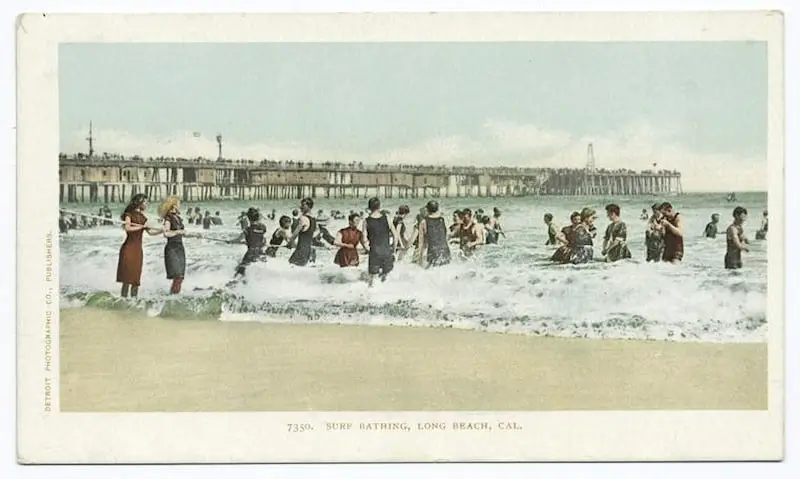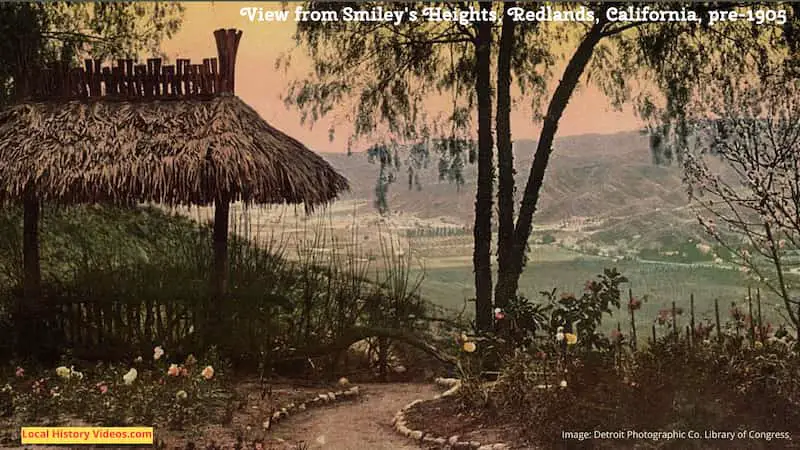Glimpse history through old images of San Bernardino, California, in the USA.
Old Photos of San Bernardino

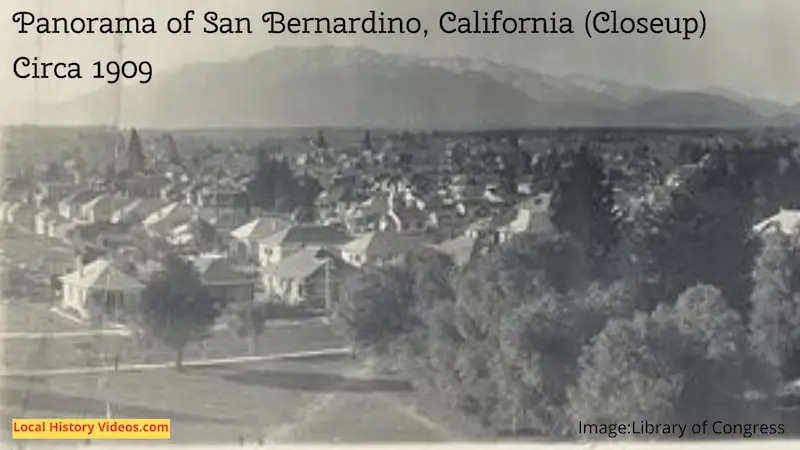

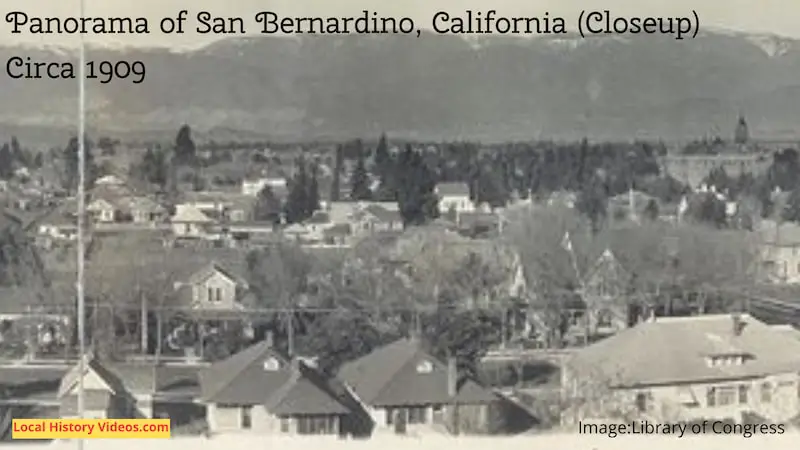
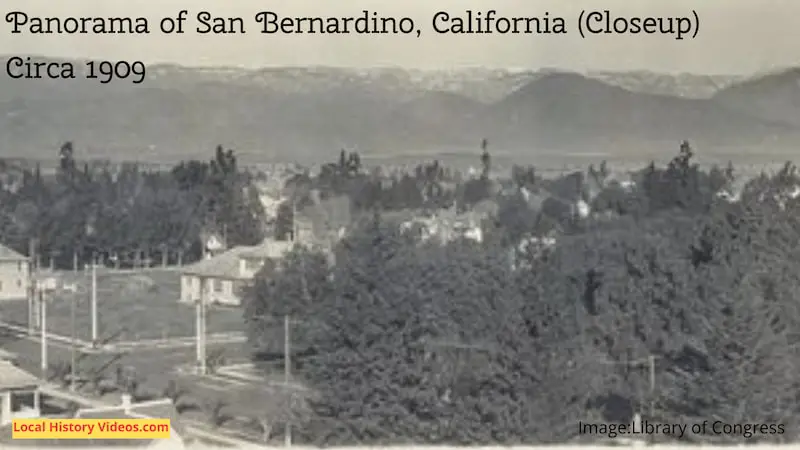

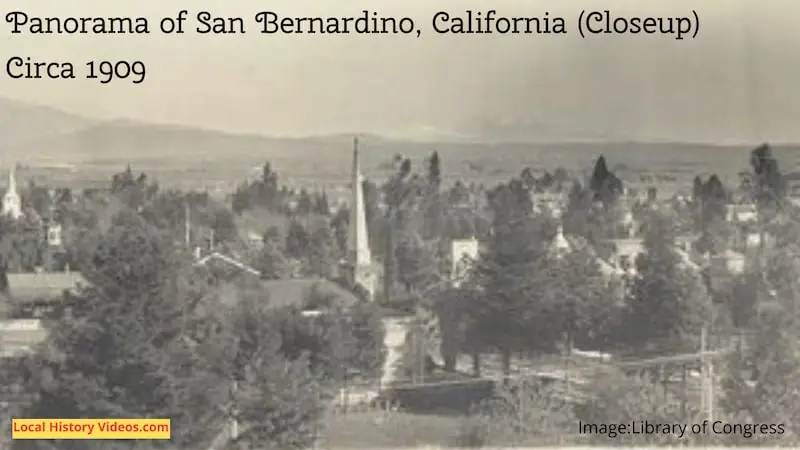
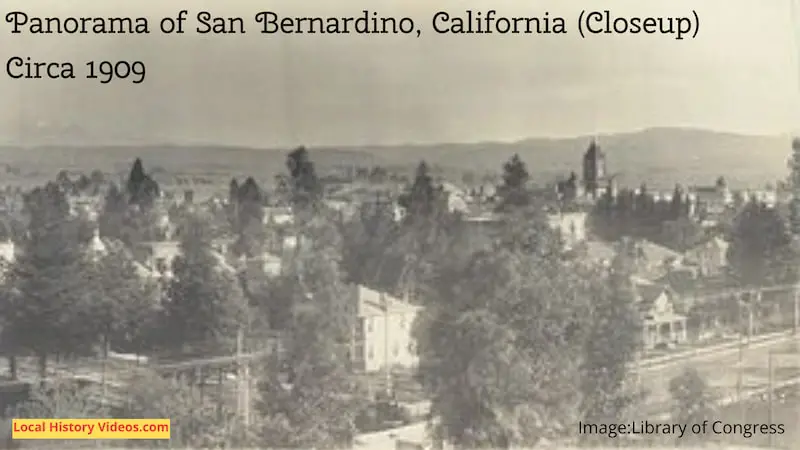
Orange Rolling Race (1930)
USA: Orange-rolling race in San Bernadino (1930) – British Pathé on YouTube
Forest Fire (1956)
In 1956, a jet plane crashed into the mountainside near San Bernadino, causing a huge forest fire.
Almost 2,000 fire fighters arrived in the Arrowhead district to tackle the blaze, but it took four days to get the fire out.
Luckily, no one died from the fire. The newsreel doesn’t give any information about the plane’s occupants.
The rest of the newsreel is dedicated to events elsewhere.
News Flashes Forest Fire, Seretse Prepares To Return Home, Zoo Babies & Babe Zaharias Dies (1956) – British Pathé on YouTube
Driving in 1995
On May 18 1995, a local resident used a home movie camera to record a nighttime drive around San Bernadino’s streets. Obviously, the store fronts are unlit, but the street lighting means you can still see a lot of the buildings, cars and people from that time.
About four minutes in, the footage changes to a drive through Fontana on May 20 1995.
A Bit of San Bernardino History
Enjoy an extract from a historic book.
“The County of San Bernardino, California, and Its Principal City – A Descriptive and Historical Sketch”
By Edson D. Hale
Published in 1888
Pages 29 – 38
” ‘Tis the month of July, 1882. The overland train is drawing up to the Colton station one hot and dusty day. The passengers have had a sultry and wearisome journey across the wastes of sand which stretch between Deming, New Mexico, and Banning. As the train emerged from the San Timoteo Canyon, all welcomed gladly the sight of fresh, green vegetation once more. El Casco, Old San Bernardino, and Mound City sweep by in panoramic view, and the train halts beside a long platform. Our ears are greeted by many cries:
“Fresh peaches, five cents a bag!”
“Peaches and apricots!”
“Ripe watermelons, ten cents a piece!”
“Who wants some fruit?”
We leave our recent companions of the journey effecting purchases from the small boys who crowd under the car windows, and descend to the platform.
“Take the second coach for San Bernardino!”
“Fifth coach goes to Riverside!”
“This way, sir, for San Bernardino, third coach!”
“Do you wish to go to San Bernardino?”
The travelers who have disembarked from the cars surrender themselves quickly to one another of these loud-voiced drivers. Then the jargon ceases. A line of five or six Concord coaches, each with its four horses, waits on the opposite side of the platform. We single out the pleasant-faced man who drives the mail-coach. The trunks are strapped on behind, the leather bags thrown into the boot, and we are off. That ride of three miles to San Bernardino, extended the same day to a point eight miles east, was the writer’s introduction to San Bernardino County.
Our friend, the driver, beguiled the journey by tempting accounts of the productions of the valley. Large stories they sounded to us at the time, but since then experience has proved them all true. ‘Do oranges do well in this county?” we ventured to ask. “Oh, my goodness, yes,” was returned with emphasis. “Here is a six-acre orchard that was set out with Washington Navel oranges six years ago, when the trees were three years old from the bud. It yielded two thousand boxes this winter. Three times two thousand is six thousand dollars that man got off from his place.”
“How much did it cost him for work and necessary expenses?” “Oh, about two hundred dollars, this year.” “Do you have any pears here?” “Oh, my goodness, yes. Bartlett pears that big!” holding up his brawny fist.
While this conversation was going on the rumbling stage had gone over the knoll north of Colton, crossed the valley between the two towns, forded Warm Creek, and entered the principal street of San Bernardino.
The town as it was then may be described as a rather sleepy place. Its population was only about two thousand inhabitants. Most of the buildings along the two principal streets were only one story high, and gave the place the air of a frontier town. There was not a horse-car within its limits; no telephone; no electric lights; hardly any improvements were to be found. No railroad then reached the place, and visitors were obliged to come by stage three miles from Colton. As one thinks over the progress and improvements of the six years since 1882, and then compares the city of that year with the original town laid out in 1853, the changes of the last six years seem to be greater than those of the first thirty years of its history.
The Mormons showed their usual shrewd judgment of localities when they surveyed and started the town. They selected a point near the center of the valley that was surrounded by the choicest farming land and several streams of living water. It has since been discovered that artesian water can also be easily obtained in the area. The city is laid out based on the cardinal points of the compass and occupies a square mile. The streets are all 82.5 feet wide, with those running east and west labeled with numerals and those running north and south labeled with letters of the alphabet. The blocks contain eight acres each, and the town was laid out on a liberal scale considering the needs of the valley in 1853. However, the town has expanded far beyond its original boundaries. In 1853 and again in 1886, it was incorporated as a municipality, and in 1885 the Santa Fe Railroad connected it to the rest of the country’s commerce network. Since that time, the progress of San Bernardino has been constant, with new business blocks continually being constructed along the principal streets, even during dull summer months like July 1888 at the time of this writing, when the money market was unusually straitened, building in the city is very active. New business blocks are crowding one another along the principal streets.
One of the most noticeable features of San Bernardino is its abundant supply of running water. There are three hundred artesian wells within the city limits, and their flow is unfailing. In many places small steam pumps, run by a gas jet, force the water into a tank at the top of the house for domestic purposes. Water is so abundant here in a country which is for the most part dry, that San Bernardino has gained the title of the “Fountain City.” It is also called the “Garden City,” for reasons that are quite obvious as one drives around the residence streets. Nearly every house is fronted by its green lawn, and embowered in a circle of trees – oranges, pepper trees, palms, walnuts, apples, and other trees of the temperate and semi-tropic zones – roses, lilies, climbing vines and flowering plants, almost without number, beautify all the homes. Fountains and rockeries adorn a dooryard here and there. The streets abound with shade trees. Wherever you look through a vista of them you see in the distance the boundary wall of mountains securely guarding the valley which blossoms at their feet. San
Bernardino is beautiful both in its natural situation and in its adornment by man. Commercially speaking, the city has the best location there is in the county. From the earliest times, it has been the business center of the valley. As the country has become settled, and new towns have sprung up upon all sides, each one has contributed to the growth of San Bernardino. The railroad towns which have been spoken of heretofore are auxiliary to the County Seat. So are the settlements in the East San Bernardino Valley, which have not been described as yet. They all look to this city, not only for their legal and judicial business, but also as their commercial center. The railroad facilities of San Bernardino contribute to this end, and are, therefore, worthy of more than a passing notice.
Five different routes send their trains daily into the Santa Fe depot at San Bernardino, making it unquestionably the railroad center of the county. To enumerate these, there is first, the Overland Route, running north and east via Barstow and The Needles, to join the main line of the Atchison, Topeka and Santa Fe Railroad at Albuquerque. Many of the excursion parties which have come into California from the Eastern States during the past two years have traveled over this route.
In passing, it may not be out of place to say that for families, or ladies traveling alone, excursions furnish the most desirable way of reaching California. They are numerous now, and several leave Chicago every week. The Raymond is exclusively first-class, and travels only in Pullman cars. It furnishes accommodations at the leading hotels, carriages, drives, attendance, and all the necessaries and conveniences of the trip. The route is planned to include visits at all places of interest, and journeys over all lines. The sight-seer has no worry or responsibility. He only has to enjoy each day’s opportunities for pleasure as they pass. The excursion may be joined at any of the principal cities of the East, and after the expiration of the allotted number of weeks, the traveler is returned to the point of starting. This mode of journeying is a luxury. For one who does not wish the care of planning, it is the ideal trip. But, like all luxuries, its cost places it beyond the reach of the average pocket-book. For persons who wish to make the journey economically and at the same time comfortably, the so-called “Third-Class Excursions” may be recommended. The tickets used are third class and do not entitle the holder to stop-over privileges, nor to the use of Pullman cars. But this latter is no real discomfort, for “tourist sleepers” are used instead, which make up very comfortable beds at night. The cars are not upholstered, but the excursion managers furnish mattresses for beds and curtains to inclose the separate sections. The traveler needs to furnish a pair of blankets and such other conveniences as he may require. Full information in regard to these excursions may be obtained at any railroad ticket office.
Because these parties travel on “immigrant tickets” no person need think that they provide poor accommodations. Only pleasant and respectable people will be met with. The journey from the East will be made on the same train, and, therefore, in the same time as the first-class cars. The luxury and ease of travel will not be so great as in a Pullman car, but there will be no serious inconvenience. One third-class excursion, A. Phillips, starts from Boston; Warner Bros., Geo. Phillips, and other parties, start from Chicago. Some of these managers now carry excursions over the lines of the Santa Fe system exclusively, and without change of cars between Chicago and San Bernardino or Los Angeles.
The second railroad route from San Bernardino is westward along the line of the foot-hills of the San Bernardino and Sierra Madre ranges to Los Angeles and the shores of the Pacific at Ballona Harbor. This road passes through a beautiful section of the country, being so elevated that it overlooks the broad valley southward all the way. Since the road was opened in 1887, Rialto, North Cucamonga, and North Ontario have sprung up along its line, and there are many other thriving towns passed after we cross into Los Angeles County.
Turning now to the southwest, the third line of the Santa Fe runs, as we have before described, through Riverside and Rincon to Santa Ana, San Juan-by-the-Sea, and Oceanside, to San Diego. The route going directly south to San Diego, over which the through trains pass, goes over the same rails to East Riverside or Citrus Junction, and then strikes off through Box Springs Canyon for a short cut to the Bay City of the South.
The fifth and last of the Santa Fe lines runs east from San Bernardino, passing through Old San Bernardino, Redlands, and Lugonia to its terminus at Mentone, in the eastern end of the valley, near Crafton.
Over these roads, trains are arriving and departing constantly, making San Bernardino one of the busiest railroad towns in the state. The Santa Fe Company has made San Bernardino the headquarters for their system of roads in California. They have already invested here over two hundred thousand dollars in a foundry, machine and repair shops, and other improvements necessary for the transaction of their business.
The through line of the Southern Pacific passes only three miles from the city limits. A right of way into San Bernardino has been secured, and the road will probably be built, at an early day, into the city and on to the East San Bernardino Valley.
Three steam motor roads are already running out of San Bernardino to its various suburbs. The Southern California Motor Company has built a standard gauge road from San Bernardino to Colton, and they are currently extending it to Riverside. Over this road, twelve trains pass in each direction every day. The San Bernardino and Redlands Railroad connects these two places with frequent trains. The road passes through a beautiful farming section and provides one with a view of some of the best orange groves in the county, at Old San Bernardino. The third road is already built from San Bernardino to Harlem Springs. It will be extended to Arrowhead Springs, Waterman, and then it will follow the windings of a canyon to climb to the summit of the San Bernardino Range. Here, it will reach the great timber belt of the county and will find its terminus upon the shores of Bear Valley Lake.
Besides steam lines of communication, an electric road has been built, although it is not yet in operation. All the principal streets of the city are traversed by horse-car tracks as well. Such are the marvelous changes in San Bernardino since 1882 when the city did not contain a rod of track of any description.
The progress in the number and style of houses built is almost as remarkable as the activity in railroad building.
The County Court House was erected in 1878, and was the finest building in the county prior to 1882. We can mention only a few of the more important buildings which have been completed since then.
The Opera House has been called the most elegant one of its size in the State. Its seating capacity is one thousand.
The principal public school building in the city is a brick structure built in the form of a Greek cross. The plan was taken from the Langdon model of a school-house which took the premium at the Centennial Exhibition. Its peculiarity is in having a common central corridor into which every one of the fourteen school-rooms open. The public school property in the city is valued at one hundred and fifty thousand dollars.
The Stewart Hotel was completed about six months ago. It is a four-story brick structure with stone trimmings. It fronts one hundred and forty-two feet on Third Street, and one hundred and forty-eight on E Street, and would be an ornament to any city. The Post Office Block, on the corner of Fourth and E Streets, is a handsome three-story building, just completed. In the past year, a large number of brick business blocks have been put up, costing from twenty to sixty thousand dollars each. The change in the appearance of the business streets is striking.
The principal street of trade in San Bernardino is Third, beginning at C Street, on the corner of which Starke’s Hotel is situated, and running west one mile to the railroad depot.
D Street between Third and Fourth, and recently E Street between Second and Fourth, are also busy avenues.
Trade extends beyond these limits, of course, but here it centers. The amount of business done in San Bernardino exceeds that of most cities of its size. It is the trading place for a large part of the county. Every train and motor coming into the city brings money to its merchants. The location of the county offices here inevitably swells the volume of business.
The Post Office had cash receipts last year of over ninety-five thousand dollars. There are four banks in the city, all of which are in a prosperous financial condition.
Besides the Stewart Hotel, there are several other good hostelries, such as the St. Charles, The Southern, and Starke’s. In the King, Occidental, Star, and many other lodging-houses, the transient visitor can obtain a well-furnished room for ten to thirty dollars per month.
The city is illuminated by gas and electricity. The dynamo by which the electricity is generated is run by water power furnished by Warm Creek. Three thousand inches of water with a fall of forty feet provides force sufficient to manufacture electricity for the whole valley. The system will quite likely be extended to the neighboring cities and towns.
San Bernardino contains churches of all leading denominations of Christians, most of which have commodious houses of worship and parsonages. The new brick church building of the Methodists is a handsome piece of architecture. The Young Men’s Christian Association occupies rooms on D Street. There are three daily newspapers, the Times, Index, and Courier. The San Bernardino Board of Trade has rooms on Third Street. Although the Board was organized so recently as November, 1887, it has already done much to advance the interests of the city and county. The city has no indebtedness. The city rate of taxation is only sixty cents per hundred dollars. The city valuation is $3,350,205. This includes only what is within the corporate limits, one mile square. City improvements exist on all sides of the incorporated town and should be fairly included in comparing San Bernardino with other cities.
Such, in some of her main aspects, is the chief city of the county. The items here given will afford the stranger some idea of the San Bernardino of the present and of the past. Her future is assured. She is not yet a large city, but she is a growing one. Her progress in the coming days will be more rapid than in the past, for now she is furnished with all the means of growth. A central position, railroad communication in all directions, a large and fertile surrounding territory, good hotel accommodations, an abundant water supply, and large but undeveloped water power, are the special points in her favor. A town which has all of these in addition to the other advantages of climate and production common to Southern California, is certainly on the flood tide of prosperity. The future of San Bernardino we will not attempt to write.”
More about California
- California Gold Rush Facts
- Old Images of Stockton, California
- Old Images of Santa Rosa, Califonia
- Old Images of Santa Ana, California
- Old Images of San José, California
- Old Images of Riverside, California
- Old Images of Oakland, California
- Old Images of Long Beach, California
- Old Images of San Bernardino, California
- Old Images of Redlands, California

